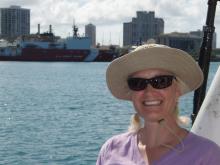What Are They Doing?
A diverse research team aboard the U.S. Coast Guard Cutter (USCGS) Healy conducted sampling along a series of transects over the eastern Bering Sea. Research on the ship was multidisciplinary, as part of the Bering Ecosystem Study, with scientists using a variety of techniques to measure the productivity of the Bering Sea ecosystem. Research teams measured the temperature, salinity and nutrient content of the sea water, changes in sea ice cover, and the concentration of nutrients used and released by phytoplankton. They also conducted surveys of zooplankton, fish, seabirds, and marine mammals such as walruses and seals, to assess the health of these populations. These measurements helped give scientists an indication of the status of the Bering Sea ecosystem and any potential changes occurring in the marine environment that might change the continued use of its resources, and the economic, social and cultural sustainability of the people who depend on it. Click here to go to the Bering Sea Ice Expedition webpage.
Where Are They?
The team traveled on the USCGC Healy in the Bering Sea. The Bering Sea lies to the west of Alaska and to the east of Russia. The team departed from and returned to the port of Dutch Harbor, Alaska, the most productive fishing port in the United States.
Latest Journals

Raymond Sambrotto is the chief scientist on this Bering Sea Ecosystem Study cruise and studies marine plankton ecology and global nutrient cycles. Dr. Sambrotto has worked from small boats in the Caribbean to major oceanographic programs in the Arabian Sea. He has worked extensively at both poles using icebreakers and submarines to traverse these difficult environments. An important part of Dr. Sambrotto’s research is determining how marine populations will fare under changed climate conditions and how these changes will affect the larger global environment.




